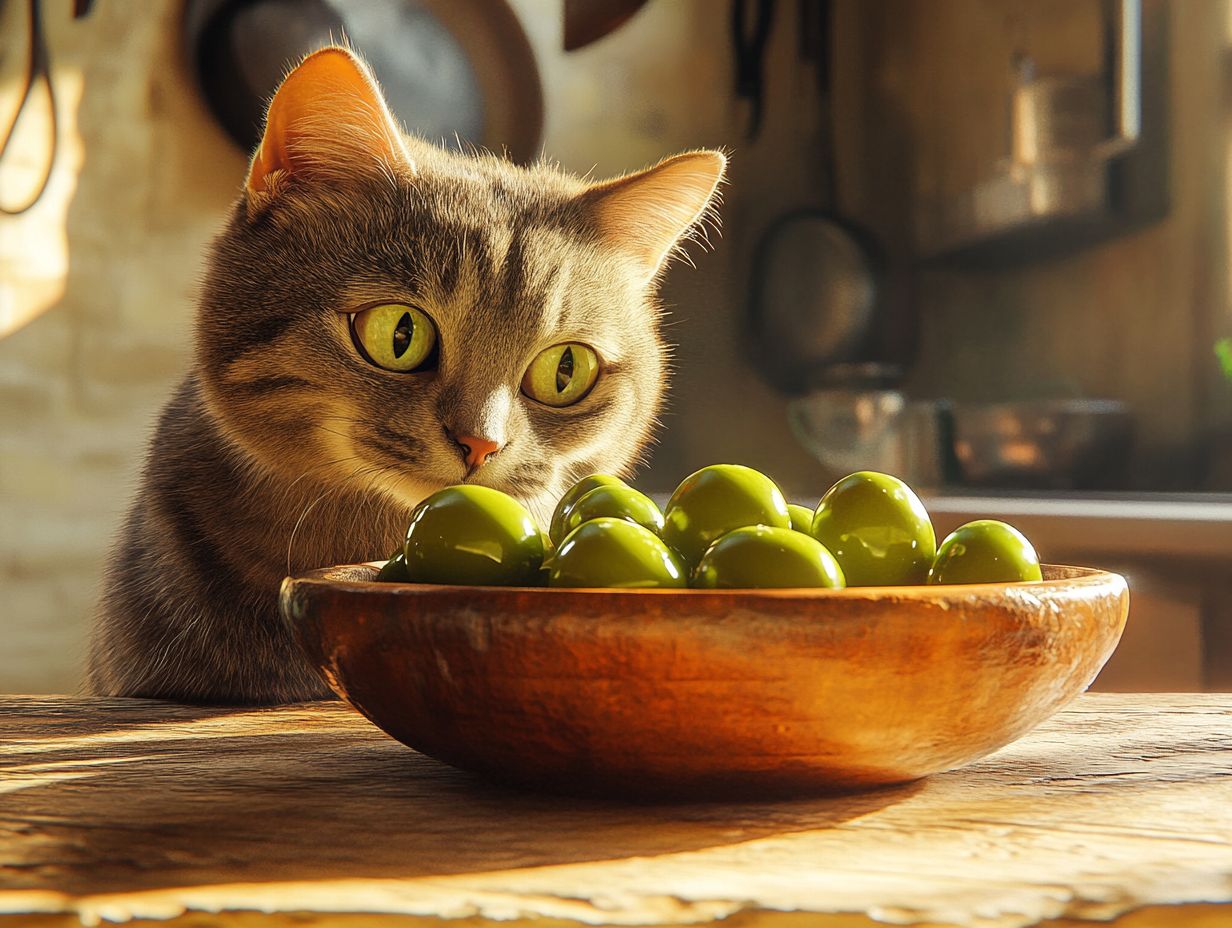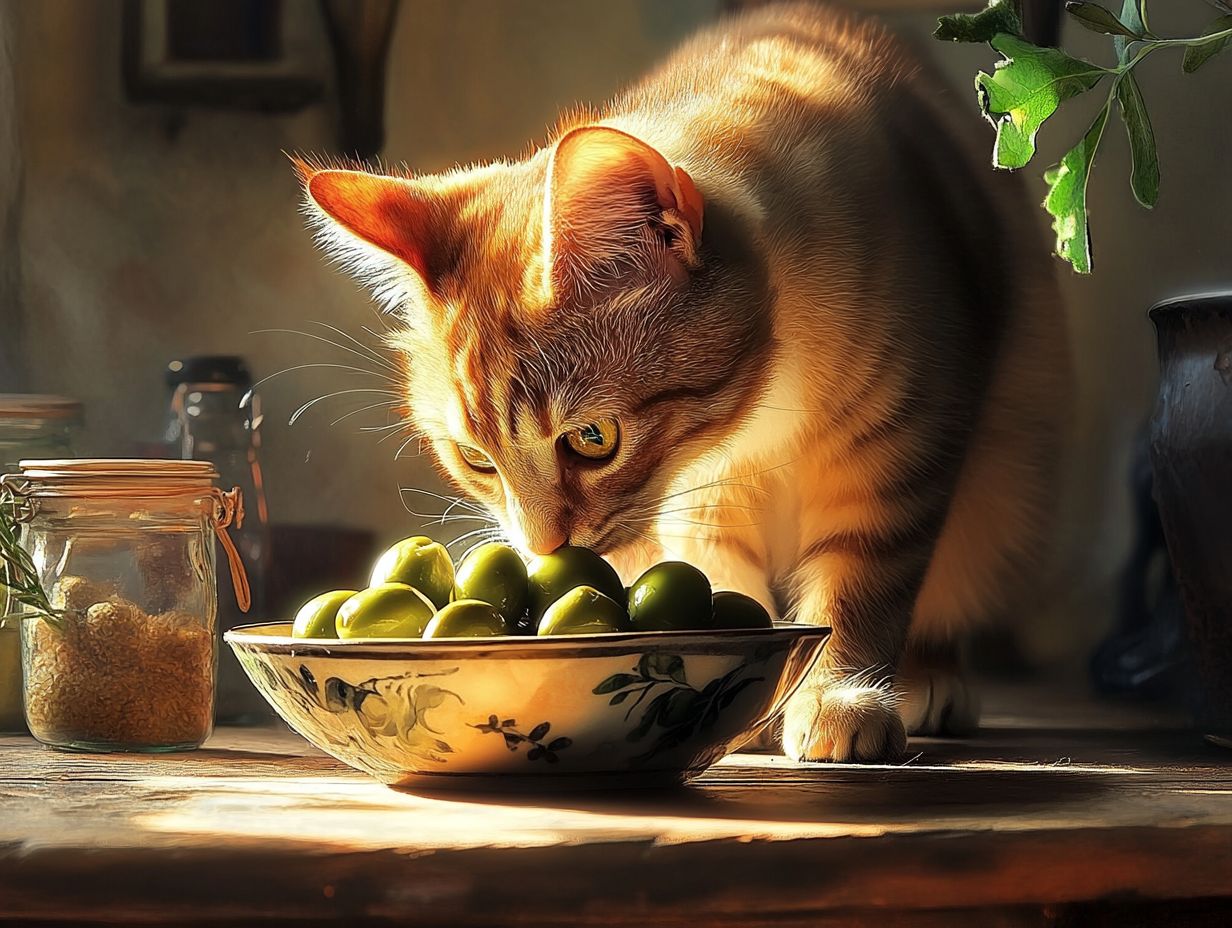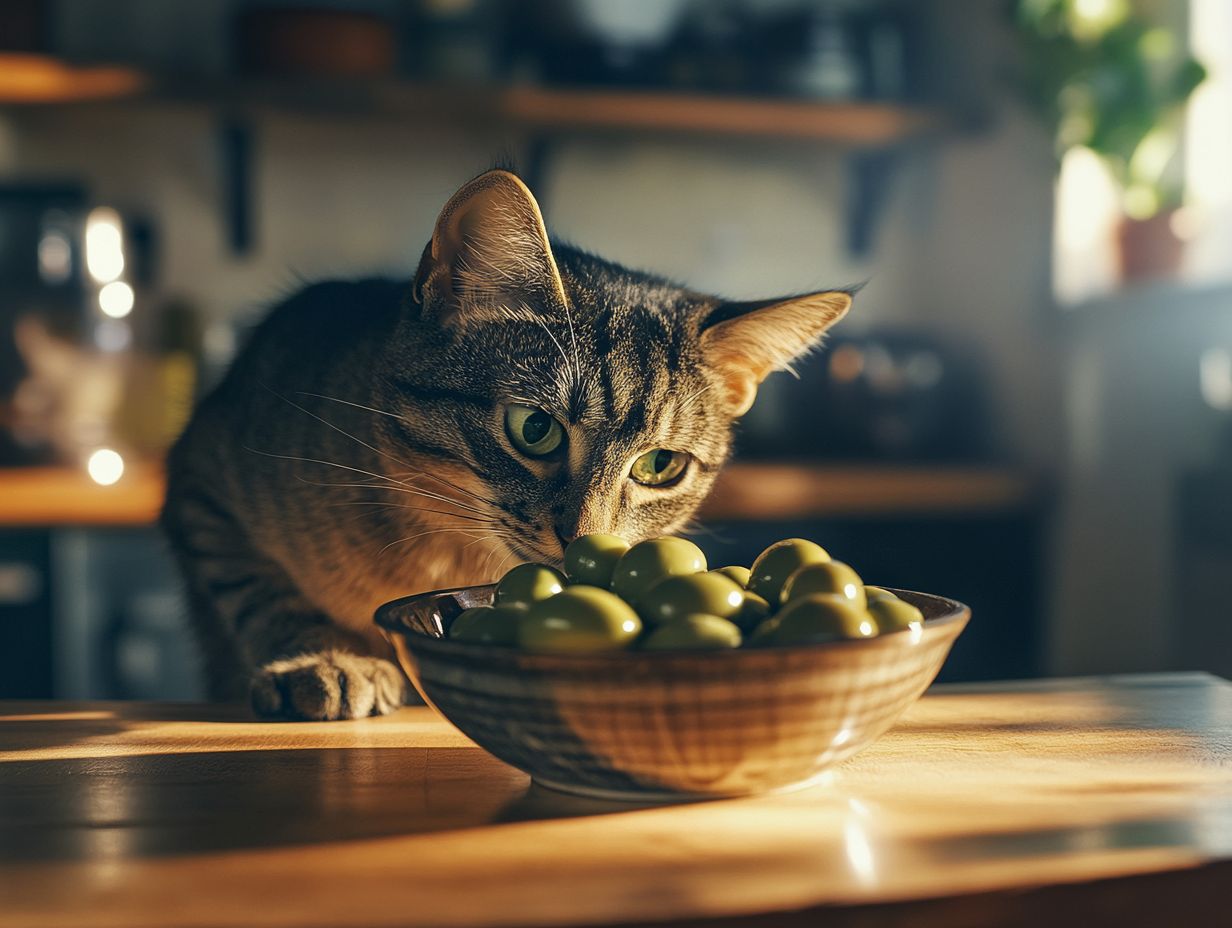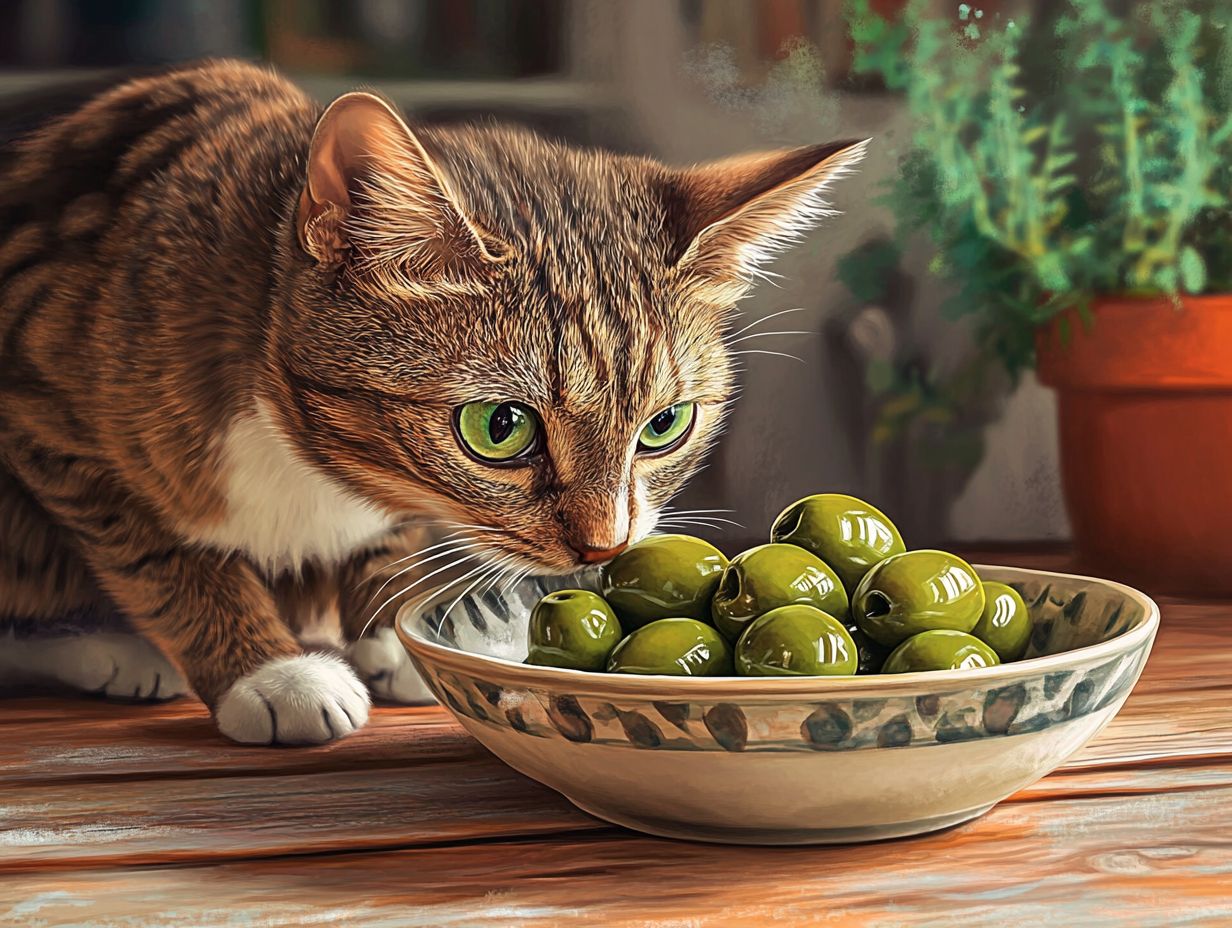Can Cats Eat Green Olives? FAQ
- Can cats eat green olives? Yes, but it’s crucial to understand both the benefits and risks.
- What are the risks? The high sodium content in olives can cause dehydration and high blood pressure, leading to severe health issues.
Cats, known for their curious behavior, often eye our snacks with intrigue. One such snack that might catch their fancy is green olives. But can cats safely eat olives?
This article explores the dietary needs of our feline friends, discussing what they should and shouldn’t eat, including the health risks associated with green olives. We also cover black olives, olive oil, alternative treat options, and tips on introducing new foods like unsalted olives to your cat.
Join us to ensure your kitty’s diet is both tasty and healthy!
Key Takeaways:

- Cats have specific dietary needs that must be met to maintain their health and well-being.
- While green olives may provide some health benefits, such as antioxidants, they can also pose significant risks like sodium poisoning and should be fed in moderation.
- Incorporating alternative treats into a cat’s diet can offer variety and essential nutrients without the potential risks of green olives, such as high sodium content and choking hazards from olive pits.
Understanding Cats’ Dietary Needs
Understanding cats’ dietary needs is essential for their well-being, as their nutritional requirements differ significantly from those of humans and dogs. As carnivores, cats must consume animal protein to thrive.
Pet owners should be aware of what constitutes a balanced diet for their cats to prevent health issues like metabolic concerns due to improper feeding. Consulting a veterinarian, like Dr. Patricia Squillace from Veterinary Care Group, can provide tailored dietary recommendations that consider specific medical conditions and lifestyles, promoting feline health and longevity.
What Cats Should and Should Not Eat
Understanding cats’ diets is crucial, particularly regarding toxic foods and those that contribute to optimal health. Knowledge of safe versus unsafe foods is essential for pet owners to help their cats maintain good health and avoid dangerous situations. While cats derive most of their nutrition from meat, they can safely consume certain vegetables and grains in limited amounts.
Safe foods for cats include:
- Cooked chicken
- Turkey
- Fish
- Some vegetables, such as peas and carrots, which can serve as excellent snacks.
Unsafe foods for cats include:
- Chocolate – can cause severe poisoning.
- Onions and garlic – harmful to red blood cells.
- Foods high in sodium, like olives, can contribute to heart disease.
To choose suitable foods for each cat, owners should seek veterinary advice from professionals like PangoVet.
Can Cats Eat Green Olives?
If you’re considering adding olives to your cat’s diet, it’s essential to understand both the benefits and risks. Many pet parents wonder whether cats can eat green olives and consider adding this food to their pet’s diet. However, it is crucial to evaluate both the potential positive and negative health effects before making this decision, focusing on sodium poisoning, stomach problems, and food safety precautions.
Benefits and Risks of Feeding Green Olives to Cats

Feeding green olives to cats has benefits and risks. On the plus side, green olives offer antioxidant properties and can be a fun treat. They provide healthy fats and other nutrients that support a cat’s overall health. Certain compounds, such as nepetalactone found in catnip, may also help reduce inflammation, while antioxidants could decrease oxidative stress, potentially enhancing a cat’s immune system.
However, the high sodium content in green olives poses a significant risk. It can cause dehydration and high blood pressure, leading to serious health issues in a cat’s sensitive system. Therefore, olives should be considered an occasional snack that offers enjoyment and nutritional benefits, but they must be given in moderation (one or two small olives as a treat is sufficient) and as a supplement to an already balanced diet.
Tips for Safe Feeding
- Start with a small piece and observe your cat for any adverse reactions.
- Always introduce new foods gradually.
- Remove pits from olives to prevent choking hazards.
- Consult your veterinarian if you have concerns about your cat’s diet.
Alternative Treats for Cats
In conclusion, while green olives can be offered as occasional treats, it is crucial to prioritize moderation and consult your veterinarian for tailored dietary advice to ensure your cat remains happy and healthy.
For pet parents looking to replace their cat’s regular treats, consider offering cooked chicken or tuna packed in water as safe options. There are numerous healthy alternatives that satisfy their taste preferences and meet their dietary needs for optimal health.
Nutritious and Safe Options
Healthy cat treats can include natural foods and specially designed commercial products formulated for feline health, allowing pet parents to offer enjoyable snacks without compromising their cat’s well-being.
For example, cooked chicken without seasoning or bones is a delightful protein-rich treat that can enhance a cat’s diet. Similarly, tuna can be a tasty indulgence when served in moderation, packed in water instead of oil. If you’re curious about other foods, you might wonder, can cats eat green olives or black olives?
Specialized commercial cat treats are formulated to meet the dietary needs of felines, focusing on balanced nutrition while providing enticing flavors. When introducing any new snack, it is crucial for cat owners to consider food safety, ensuring that each option aligns with their pet’s health requirements.
Ultimately, incorporating these safe treats into a cat’s routine can foster bonding while keeping them happy and healthy.
How to Introduce Green Olives to Cats
To introduce green olives to your cat, follow these steps:
- Ensure Safety: Before offering green olives, verify that they are safe and not an allergen for your cat.
- Start Small: Offer only one or two small pieces initially, especially if it’s your cat’s first experience with them.
- Observe Behavior: After giving your cat green olives, monitor their reaction. If the response is positive, you can offer green olives again. If negative, refrain from giving them to your cat.
Tips for Introducing New Foods to Cats

When introducing new foods to cats, such as green olives, pet parents should follow these guidelines to ensure a smooth transition while minimizing health risks and adhering to veterinary advice.
-
Start with Small Portions
Begin with small portions to assess how well your cat tolerates the new ingredient. Monitor any changes in behavior, such as excessive grooming or lethargy, which may indicate discomfort.
-
Be Observant for Allergies or Gastrointestinal Issues
Pay close attention to signs of allergies or gastrointestinal problems. Keeping a food diary to track your cat’s reactions can be beneficial.
-
Seek Veterinary Advice
Consult a veterinarian before making significant changes to your cat’s diet to receive guidance tailored to your pet’s health needs.
Benefits of Green Olives
Green olives can offer enjoyment for cats, providing a unique flavor experience. However, they should be served in moderation and not be a staple in a cat’s diet due to their high sodium content.
Risks of Feeding Olives
Feeding cats excessive treats, including olives, can lead to health concerns like obesity and pancreatitis. Always prioritize moderation.
Final Thoughts and Recommendations
While green olives can be an enjoyable condiment in a cat’s diet, pet owners must consider several factors, including veterinary recommendations and the overall dietary needs of their cats.
Not all cats react the same way to new foods; some may enjoy the taste of olives, while others might be indifferent or even have negative reactions. Therefore, moderation is essential. It’s wise to start with a small amount and monitor for any signs of digestive upset or allergic reactions when introducing any new food item.
Maintaining a balanced diet primarily consisting of high-quality cat food, along with occasional cat treats, will help ensure that all nutritional requirements are met. Consulting with a veterinarian will provide the best guidance tailored to an individual cat’s needs, especially in preventing potential issues like arthritis and heart disease.
Frequently Asked Questions
Can cats eat green olives?
Yes, cats can eat green olives in moderation. However, they should not be a regular part of their diet as they do not provide significant nutritional value for felines.
Are green olives safe for cats?
Green olives are generally safe for cats when offered in small amounts. Always consult your veterinarian for personalized advice.
What other foods are safe for cats?
Safe options include cooked meats like chicken and turkey, certain vegetables like carrots, and commercially available cat treats.
How can I tell if my cat is having a negative reaction to a new food?
Watch for signs such as vomiting, diarrhea, excessive grooming, or lethargy. If any of these occur, discontinue the food and consult your vet.

Wondering if green olives are safe for your feline friend? This guide provides essential information about feeding green olives to cats, including benefits, risks, and best practices.
Are Green Olives Safe for Cats?
Green olives are generally safe for cats to consume, as long as they are not allergic. However, ensure you remove the pits before feeding them to your cat to avoid choking hazards.
Can Green Olives Be Toxic to Cats?
No, green olives are not toxic to cats. However, they do contain a high amount of sodium and fat which, if consumed in large quantities, can lead to digestive upset or pancreatitis. Excessive sodium can also contribute to health issues such as hypertension in cats. Limit green olives to one or two small pieces per week to avoid complications.
How Should I Feed Green Olives to My Cat?
Green olives should be given as an occasional treat in small quantities. Start with one small piece to observe any adverse reactions. Offer no more than 2-3 small pieces per week, depending on your cat’s size. Always serve them plain, without seasoning, and remove the pits before feeding them to your cat.
What Are the Benefits and Limitations of Green Olives for Your Cat?
Green olives do not offer significant benefits for cats. However, they contain healthy monounsaturated fats, which can help improve a cat’s coat and skin health when consumed in moderation. Always consider your cat’s overall diet and the risks associated with sodium content.
What Are Some Alternative Treats for Cats?
For alternative treats, it’s best to stick with options specifically made for felines. Brands like Greenies or Temptations are popular. You can also offer small pieces of cooked, unseasoned meats or fruits like apples, bananas, blueberries, or carrots as occasional treats. Always consult your veterinarian before introducing any new treats into your cat’s diet to ensure they align with your pet’s health needs.